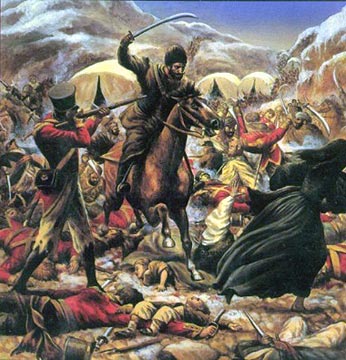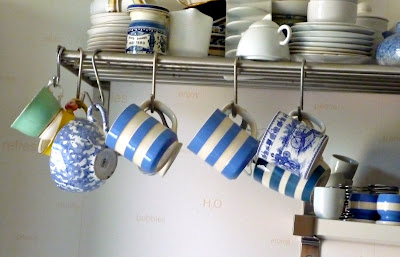Glen Affric is reputed to be one of Scotland’s loveliest glens. Certainly the lower and middle sections are very attractive with lochs and wooded areas full of traditional Scottish trees - the Scots Pine, Ash, Rowan etc. The upper part of the glen is rather different in character - boggy, treeless and more a degraded landscape than anything else. It is also very isolated - there is no road into this part of the glen. However it does have a beauty of its own and more importantly it is the setting for a youth hostel - Alltbeithe. For upper glen Affric is the base for climbing some of Scotland’s most interesting and inaccessible munros - mountains over 3000ft/914m in height. Below is an example of what you can expect in upper Glen Affric. This shows the complex mountain of Sgurr nan Ceathreamhnan (pronounced apparently as skoor nan Kerranan).
And it was to climb some of these munros that took me back to Glen Affric a few weeks ago. Though beautiful, Glen Affric, like most of north west Scotland can be a very wet and rainy place. It was when I was first there some 15 or so years ago and so it was to prove again. It all started so well, as John and I left Dundee in glorious sunshine. The first sign of trouble came as we reached the turn off to Loch Laggan and Fort William. It was closed! An oil tanker had spilled over and the road was to be closed for at least two hours. We decided to take the long detour via Inverness. And shortly afterwards the weather changed and we had our first rain shower. The weather gradually got worse the further we went.
The only way in to the hostel in Glen Affric is by walking or cycling. As the hostel has no store, you have to carry everything you eat in with you. This makes for a rather heavy rucksack. The shortest route in is from Cluanie on the road to the Isle of Skye. Even this takes about three hours. Luckily, by the time we reached Cluanie, the sun was out again. This was however to be a false dawn. The first third of the walk in is over a pretty good stone path. However this peters out and becomes a featureless outline. The terrain underfoot also becomes very, very boggy. And to cap it all, the rain began again. Heavier and heavier as we approached the hostel. This rain was not to stop for over 24 hours! Still we did reach the hostel without any major mishaps.
The following day we awoke to clouds and rain. Undaunted we decided to tackle two of the munros - Sgurr nan Ceathreamhnan and Mullach na Dheiragain (the last word likely pronounced Yerrigan). It is not really that difficult an outing - at least in good weather. But there are lots of up and downs and the summit ridges are very rocky. Which is not ideal terrain in the mist and rain. As the conditions were deteriorating we decided to forego the privilege of climbing the Mullach and just do the Sgurr. However, even this was very exhausting, at least for me. I have not managed out hillwalking as much as I would have liked this year, so I found the slog very tiring. So much so that before reaching the top I felt I had had enough and decided to forego even this summit. I would descend a little for some lunch and wait for John, who would go on to the top and then come down to join up with me again.
The best laid plans of mice and men! Someone wrote something along these lines a long time ago. How true they are. For at this point things went from bad to worse. I had my lunch - oatcakes and Manchego cheese. However it was so cold and I was by now so wet that after ten minutes I was beginning to chill. No alternative but to keep on walking, just to keep warm. I slowly descended a little further, and then a little further on. But no sign of John. I waited around for some time - walking back and forth on a level section of the ridge to keep warm. Still no sign of John, so after an hour or so, there was nothing for it but to go back up the mountain to see if anything nasty had happened to him. Funnily enough after all this rest, I found the ascent second time around very easy and reached the summit in next to no time. But John was nowhere to be seen. So all I could do was return to the hostel and wait and see if he turned up safe and sound. And if not call out the rescue team!
Meanwhile, John had reached the summit and gone on to make the second top further along the ridge. On his return past the main summit he took the wrong turning and ended up walking along the ridge to the Mullach! After some time walking along this ridge he realized that something was wrong, and he was lost. To cap it all the map he had did not extend as far as this part of the mountain. Luckily for John the clouds rose briefly and he was able to see where he was and what he had done. He was also able to work out the route back to the main ridge - which involved a descent and rising ascent.
While all this was happening to John, I was descending carefully down the main ridge to reach the col where the path to the hostel starts. Unfortunately I missed this point and started to descend too soon. This meant I was coming down a very steep section, at first rocky and then grassy and boggy. And all the time it kept on raining and raining. This part of the descent was so steep and wet that I fell and slipped down the grass.
However by the time I got down to a plateau section I could see John coming down the path. I soon joined him on the path and we filled each other in on what had happened. It looked like our travails were over for this day at least. Alas, no. The path crosses the burns that hurtle down the hillside and by now, after some 20 hours or more of continuous rain, the burns were now raging torrents and the stepping stones nowhere to be seen. We prodded about a bit trying to find a possible crossing point. Eventually we settled on one section that didn’t look too bad. And we did both make it across. Unfortunately in making sure we did get over the spate we both lost our balance and fell over in the water. Luckily we fell forwarded and suffered little damage. I hurt my right hip a bit - nothing serious. We did get very wet, but by then we were so soaked that some extra water made no difference at all.
After that there were no further mishaps and we at long last, after eight hours on the hills, staggered somewhat exhausted, (at least I was exhausted) back to the hostel to try and dry off and get something warm to eat and drink. We started with a well earned nip of whisky. Never been more welcome. The following day was sunny and warm. I was too tired to face up to another long hard climb to stayed by the hostel to rest. John, however did manage to complete another three munros.
Though a very tiring and for me exhausting day, the whole trip to Glen Affric was not to be missed. It is always good to test yourself now and again. And of course you do get to see some of the best scenery in Scotland. In addition you meet some very interesting and colourful people in hostels, especially one as far off the beaten track as Alltbeithe. I have now promulgated my very own three golden rules for hillwalking. 1. Never go on a long hard hike (more than six hours walking and over 700m of ascent) unless you are really fit. 2. Never go on long hard hikes on successive days unless you are really, really fit. 3. Never, ever, go on a long hard hike in the pouring rain. But do go to Alltbeithe - for an experience of a different kind.























